When folks need an elevator, we should give them an elevator, not an airplane. We’ve been giving them airplanes for 30 years, and then laughing at them for being too stupid to fly them right.
I think we’re the stupid ones.
Read more: Funkatron.com
When folks need an elevator, we should give them an elevator, not an airplane. We’ve been giving them airplanes for 30 years, and then laughing at them for being too stupid to fly them right.
I think we’re the stupid ones.
Read more: Funkatron.com
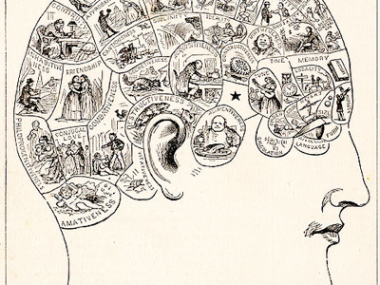 What are we to make of the new Windows Phone 7 Series?
What are we to make of the new Windows Phone 7 Series?
First, we have to distinguish it as a new platform. Let’s use Microsoft’s new naming conventions and call it “WP7S” as distinct from the current Windows Mobile 6.5 aka “WinMo”.
Steve Ballmer said they will continue to “invest” in WinMo presumably in parallel to the WP7S platform. This is an interesting development since although there might be some interoperability of applications, the new platform will likely have a new set of APIs.
What strikes a follower of the WinMo platform is that the new WP7S is orthogonal in its positioning. Whereas WinMo was for either hard core, ROM burning, .cab-editing geeks, or for corporate suits, the new WP7S is going for the Xbox, Facebook ADHD hipster user. Perhaps Microsoft is also going for the “average” user though that did not come through the presentations.
So these two constituencies (geek vs. socialite) are quite distinct and a product that pleases one won’t please the other. Evidence of this is the fact that many existing users are feeling dejected over the absence of true multi-tasking, the locked memory cards, the lack of compatibility with the old UI and apps, and the overall “dumbing down” of what they thought was a haven of nerdiness in a sea of iPhone hype.
If Microsoft pours more resources into the new WP7S at the expense of the WinMo platform then we can assume they are “firing” their loyal geek users. Frankly, they are a difficult set of customers whose advice tends to steer a product into ever-more complexity and over-service.
This sets up a potential schism repelling the geek set toward Android and the corporate set perhaps sliding toward iPhone.
That would leave Microsoft in a quixotic pursuit of iPhone users without the benefit of an ecosystem.
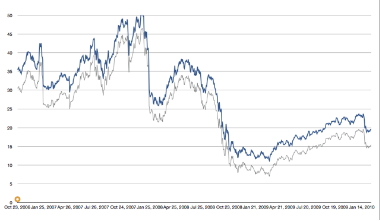 The fact that AAPL is less valuable — in terms of the P/E ratio — than the average S&P 500 company continues to baffle me.
The fact that AAPL is less valuable — in terms of the P/E ratio — than the average S&P 500 company continues to baffle me.
Apple’s P/E is a bit misleading because of the price “P” a large part is cash which should not be considered “at-risk” capital.
The logic of a P/E ratio is to measure how many years it might take to recover one’s investment. The cash on the balance sheet is not at risk for this calculation. Therefore the Enterprise Value /Free Cash Flow is a more accurate measure of company value creation. Until the recent re-statement the FCF and Earnings were divergent. They have since become equivalent.
Therefore, if you take cash out, (currently $43/share) the Enterprise Value / Free Cash Flow for Apple is about 15. It had bottomed at 7 (now that we have restated data we can go back and re-calculate this).
The graph above shows the traditional P/E in blue and the EV/FCF in grey (using restated financials).
On a forward basis the EV/FCF is probably around 12 to 13.
Also of note is that Apple’s EV/FCF is lower than the S&P 500 (at 23.52 at the end of Q4 2009.)
If we continue to use the S&P as a comparable, I looked up the estimates for quarter-end P/E for the S&P 500:
12/31/2011 17.15
09/30/2011 18.35
06/30/2011 19.97
03/30/2011 21.61
12/31/2010 23.00
09/30/2010 24.43
06/30/2010 22.57
03/30/2010 21.54
12/31/2009 23.52
Apple EV/FCF (and also traditional P/E) are lower than S&P on current and forward bases.
How do we read this? Is the market considering that Apple’s prospects are less than the average large company? This does not quite make sense to me. What other theory could be at work to explain this valuation?
S&P estimates are sourced from:http://www2.standardandpoors.com/spf/xls/index/SP500EPSEST.XLS
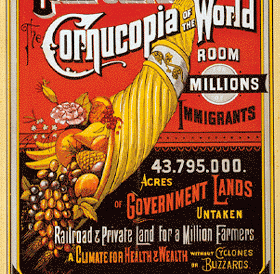 Delivering precisely what the world needs today:
Delivering precisely what the world needs today:
Three new ambitious platforms starting with zero installed bases and no applications are going up against the following:
It should be noted that Microsoft’s new Windows Phone “7 Series” will compete with Microsoft’s Windows Mobile 6.5 which will continue as a product line.
MeeGo will also compete with Nokia’s existing Symbian OS for developers, replacing Maemo.
Most of these new platforms will not have products shipping for at least 6 months during which time another 50 million (at least) new users will join existing ecosystems.
There are now nine smartphone platforms, but who’s counting? I’ve been hearing predictions of consolidation for years and although platforms have come and gone (PalmOS, SavaJe), the total number continues to increase.
If nothing else, this seems to indicate that the industry is not in any state of maturity or point of “over-service” where commoditization takes place.
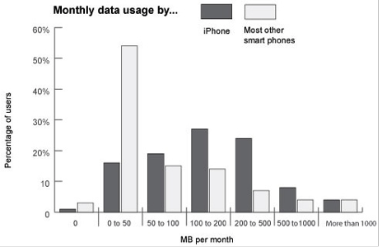 As mentioned before, Blackberries should not be thought of as smartphones.
As mentioned before, Blackberries should not be thought of as smartphones.
Consumer Reports announced this week the results of a study it commissioned assessing the monthly data usage for customers of Apple’s iPhone and other smartphones. The data reveals:
On average, iPhone users consume 273 MBs of data per month. That compares with 54 MBs for consumer users of Blackberrys and 150 MBs for consumers who use other brands of smart phones, the Validas study found.
The disparity in data usage is particularly evident at low levels, where 80% of BlackBerry and 54% of “other” smartphone users consume less than 50 MB of data per month while only less than 20% of iPhone users maintain such low usage.
As I argued in the past, Blackberries should be considered feature phones. Doing so helps to understand both their limitations and their potential.
This categorization helps put into perspective the phenomenal growth RIM is able to maintain while not being at all competitive with other platforms by any measure of performance that defines the basis of competition in smartphones.
Being a feature phone means the Blackberry just needs to be better than a dumb phone, something it’s more than able to demonstrate to a prospective buyer.
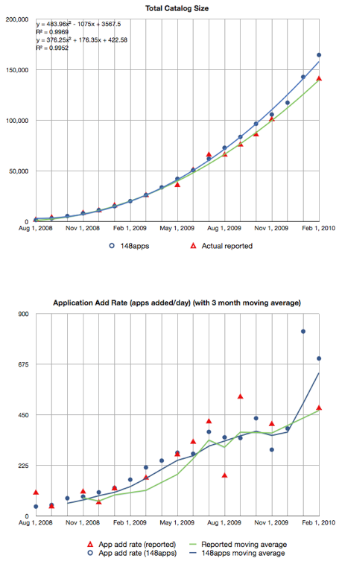 Taking the data released so far on the iTunes App Store and performing to usual regression analysis gives us a high degree of confidence that 300k apps will be achieved by end of this year and 500k well before the end of next year.
Taking the data released so far on the iTunes App Store and performing to usual regression analysis gives us a high degree of confidence that 300k apps will be achieved by end of this year and 500k well before the end of next year.
The app add rate is running at about 500 apps per day.
The graphs above show the total catalog and the app addition rate as reported by Apple and as estimated by 148apps.com.
The other useful data is that 148apps.com has had a pretty good record in tracking the catalog.
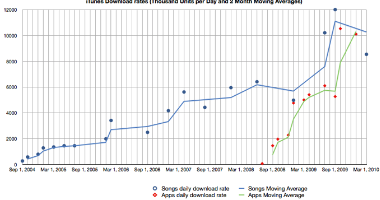 Apple just started its countdown clock to 10 billion song downloads.
Apple just started its countdown clock to 10 billion song downloads.
I combined the data available for iTunes downloads of Songs and Apps (from Wikipedia) in the graphs above.
Obviously, the App download rate is increasing (i.e apps are accelerating more rapidly) than songs. Both are averaging about 10 million units per day over the past 3 months.
A Download Totals graph also shows the acceleration plainly with the App Store getting to 3 Billion downloads in 19 months vs. 36 months for Songs. A curve-fitting analysis shows that the App store will reach 10 billion downloads 27 months after launch or around October 2010.
The same analysis shows that the App Store will overtake the Music Store in total units downloaded in December 2010 when they both reach around 13.5 billion downloads.
![]() When I heard about Android being positioned against the iPhone, I thought about how that decision must have been justified internally at Google. I wondered how Andy Rubin added up the benefits of his product vs. the risks of losing whatever value Google derived from the iPhone.
When I heard about Android being positioned against the iPhone, I thought about how that decision must have been justified internally at Google. I wondered how Andy Rubin added up the benefits of his product vs. the risks of losing whatever value Google derived from the iPhone.
On the benefits side, Android’s original business plan called for zero direct revenues with indirect revenues from search. The actual value would be somewhat dubious during the half decade it will take to get a significant installed base. Of course, with the Google-as-retailer model, Android can also be justified as earning some margin from devices, but as we’ve seen, these numbers don’t add up to much.
On the risk side there is the potential loss of the screen real estate on the iPhone (see photo above). Being the default search engine in mobile Safari might be worth hundreds of millions to Google.
Silicon Alley Insider reports a rumor that Apple’s current deal with Google to provide default search functionality for the iPhone is currently worth over $100 million per year to Apple in revenue sharing.
So the iPhone may be a bigger money maker for Google than Android will, at least for a long time.
Which begs the question of whether by picking a fight with Apple, Android is biting the hand that feeds it.
If there is any logic to this Android adventure it might be that Google really feels it needs to have an option on the future mobile computing platform and that Android is worth the risk of losing placement on the iPhone.
I, for one, don’t think this is a risk worth taking.
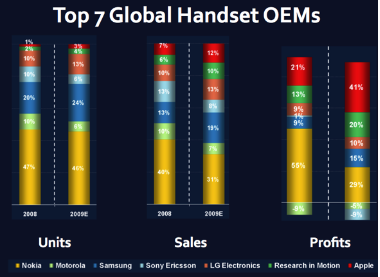 I calibrate my growth rates on the assumption that Apple will overtake the combined share of the two money-losing handset vendors.
I calibrate my growth rates on the assumption that Apple will overtake the combined share of the two money-losing handset vendors.
Sony Ericsson and Motorola are the weakest competitors in terms of portfolio and competence with software. Their sales, units and profits shares for 2008/2009 are shown in the graph above (source: Morgan Stanley).
Therefore, my thesis is that Apple could beat these two weakest competitors in 3 more years.
Here is the basic top-down view:
In 2009 174 million smartphones were sold out of a total of 1.13 billion phones (IDC, Strategy Analytics). Using a 10% CAGR on this figure gives 1.65 billion phones in 2013
Apple obtained 2.1% share in 2009 and about 1.5% share in 2008. My forecast share for Apple:
2010: 3%
2011: 4.1%
2012: 5.5%
2013: 7.5%
During the last quarter, Sony Ericsson held 4.5% share and Motorola 3.7% therefore my 2013 target for Apple is a little less than the sum of what these two hold today.
This results in unit sales for Apple of 125 million units for 2013 and a compound annual growth rate of 50% a year.
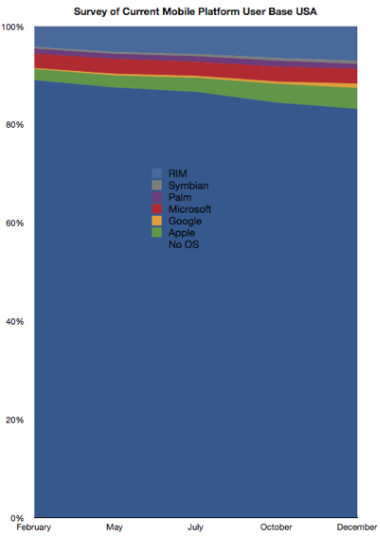 Comscore revealed their latest survey resultsfor the US mobile subscriber market. From the latest data and the data previously released in October we can put together a few insights.
Comscore revealed their latest survey resultsfor the US mobile subscriber market. From the latest data and the data previously released in October we can put together a few insights.
The number of smartphone users increased by 3.2 million, growing at over 1 million new users per month.
Apple and Android added about 1 million users each. RIM added 1.4 million with Symbian adding about 200k users. Palm lost 441k users and Microsoft lost about 44k users.
Non-smartphones lost 2.1 million users and 1 million subscribers were added to the top line.
The non-smartphones lost 1% share in the quarter and 6% since February. Smartphones make up 17% of all users.
Google has overtaken Symbian to rise from last place in the platform installed base and is closing on Palm.
At 5% share erosion per year, the non-smartphone market will completely disappear in about 14 years, though I feel 10 years is a more likely target with 5 years until the market is 50% penetrated.